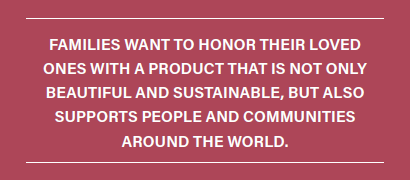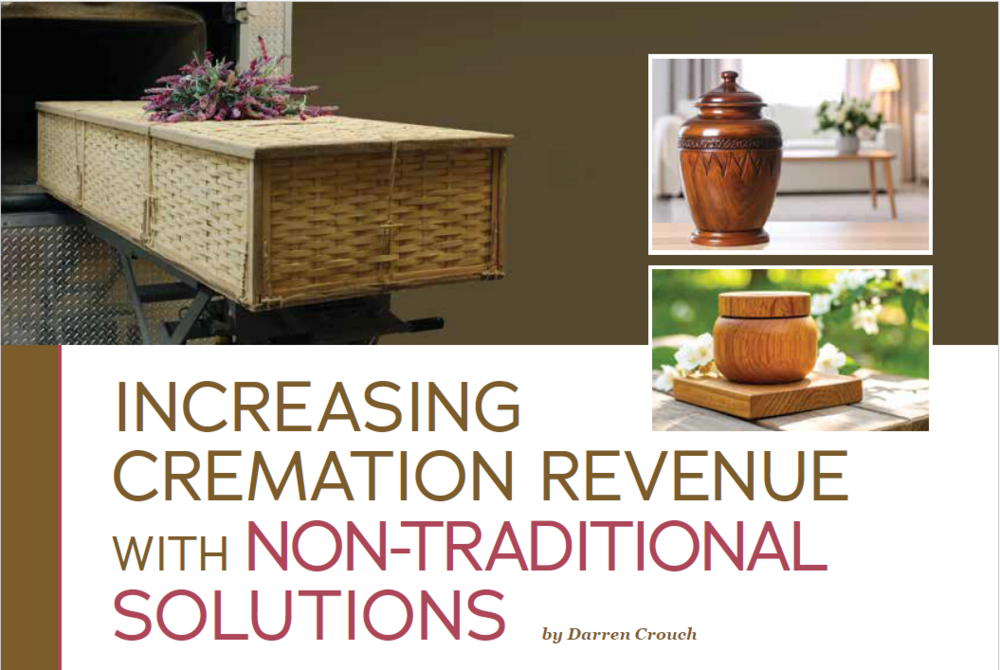(404) 312-6640
Increasing Cremation Revenue with Non-Traditional Solutions
INCREASING CREMATION REVENUE WITH NON-TRADITIONAL SOLUTIONS by Darren Crouch
As cremation continues to overtake burial as America’s leading choice for final disposition, funeral homes are experiencing an identity crisis—and an economic one. The cremation rate in the United States has quietly crossed the 60% threshold and shows no sign of slowing, projected to reach 65% or higher by 2027. On the surface, this might seem like a neutral shift in consumer behavior. But dig deeper, and the tension becomes clear: while more families are choosing cremation, fewer are spending money with funeral providers in the process.
What’s causing this growing disconnect between preference and profit? The answer lies not in the numbers themselves, but in what they signal: a dramatic realignment of values between today’s families and the services traditionally offered to them.
THE VALUE GAP
For decades, the business model in funeral care was centered around physical services—embalming, caskets, burials, and the ceremonies that framed them. These were the revenue pillars on which funeral homes were built. Cremation, by contrast, is often chosen for its simplicity, affordability, and flexibility. This can result in families bypassing the very
offerings that once ensured profitability.
Direct cremation is a prime example. It often excludesviewings, services, or even an urn. The container for theremains? Frequently a cardboard box—cheap, functional, and entirely devoid of ceremony or meaning. Some funeral directors, candidly, have described the experience of giving families these boxes as one of resignation. “It didn’t matter what urns we displayed or how we priced them,” one said. “Families would still choose the box.”
But that cardboard box has become a symbol of a much larger issue. It represents a service offering that is out of step with how modern consumers define value.
THE MODERN FUNERAL CONSUMER
Today’s families are not necessarily looking for more— they’re looking for something different. They want memorials that reflect the individuality of their loved ones. They’re driven by sustainability, dignity, and emotional resonance. According to the National Funeral Directors Association’s 2024 Consumer Preferences Study, nearly a third of burial families now prefer green options. Nearly 90% say that environmental sustainability matters when planning a funeral.
This is not a market that rejects spending altogether. Rather, it rejects spending on things that feel impersonal or misaligned with their values. The challenge is clear: funeral homes must offer something worth choosing.
RETHINKING THE CREMATION CONTAINER
The transition away from cardboard isn’t just a matter of aesthetics, it’s a matter of principle. Some funeral homes have taken a stand by removing cardboard containers entirely from their general price lists and selection rooms. In their place, they’ve introduced alternatives that better reflect the values of today’s families.
Take, for instance, cremation containers made from natural materials like bamboo. Unlike cardboard, bamboo is made from a renewable resource, burns clean, and visually dignified. Containers made from sustainably harvested bamboo, free of metal, toxic adhesives, and synthetic finishes— offer families something they can feel good about choosing. And they’re not just an ecological improvement, they’re a symbolic one.
The commitment to bamboo extends even further, embracing not just sustainability but also social responsibility through Fair Trade principles. By sourcing materials that are renewable and locally grown, and by working with communities that prioritize fairness and equity, these containers uphold the ten Fair Trade Principles: from supporting marginalized workers to promoting environmental stewardship. This dual commitment, ecological and ethical, resonates deeply with families who want to honor their loved ones with a product that is not only beautiful and sustainable, but also supports people and communities around the world.
IMPLEMENTATION AS A CULTURAL SHIFT
Of course, implementing these changes is not just about swapping one product for another. It’s about embracing a new philosophy of service—one that sees families not as customers to be sold to, but as individuals in search of meaning during a vulnerable moment.
Transitioning away from cardboard requires leadership, staff buy-in, and a willingness to revisit how value is communicated.
Funeral professionals who’ve made the switch have found success through a few shared strategies:
• Removing low-value options altogether, which signals a commitment to dignity and simplifies decision-making.
• Training staff at every level to understand the purpose and philosophy behind new offerings.
• Revamping merchandising and messaging to help families understand what makes these containers different.
• Offering flexible tiers, so families have options that align with both their values and budgets.
The shift is less about product lines and more about perspective. Funeral homes that treat cremation not as a low-cost alternative, but as a meaningful opportunity for memorialization, are the ones finding success in this evolving landscape.
BEYOND THE BOX: OTHER NON-TRADITIONAL TOUCHPOINTS
The reconsideration of cremation value doesn’t end with the cremation container. An overwhelming number of families plan to scatter cremated remains, a practice that brings its own set of challenges and opportunities. Yet many funeral homes continue to stock permanent urns in abundance despite low demand for them in scattering scenarios.

Biodegradable urns and scatter tubes, in contrast, meet families where they are. They’re designed for outdoor or nature- based tributes and offer the kind of tactile, participatory experience that many grieving families crave. Some include digital enhancements—like QR-coded memorial platforms tied to the location of scattering—that help bridge the physical and virtual worlds of remembrance.
This kind of innovation matters. It addresses a common emotional need: “Where do we go to remember?” For many, the answer is no longer a headstone. It’s a park, a mountain, a sea—and increasingly, a shared digital space.
THE BROADER IMPACT
What funeral homes are discovering is that this reimagining of cremation care creates a triple benefit:
• Families feel better served, emotionally and philosophically.
• The environment is treated with greater care, through the use of biodegradable, sustainably produced products.
• Funeral homes reclaim lost revenue, not through upselling, but by offering something people genuinely value.
This isn’t just a business model—it’s a redefinition of what funeral service means in the 21st century. It suggests that dignity doesn’t have to be costly. That meaning doesn’t have to be traditional. And that sustainability doesn’t have to be a compromise.
THE COURAGE TO CHANGE
Change, especially in long-established professions, is rarely easy. But it is necessary and a call to reevaluate what matters.
Funeral care has always been about guiding families through loss. But the way we do that must evolve with the people we serve. What’s emerging is not a rejection of the past, but an expansion of the present—one that honors life, reflects values, and protects the world we leave behind.
In the end, the choice isn’t just between cardboard and bamboo. It’s between staying static or stepping into a more thoughtful future.
The industry is changing. Families have changed. The real question is—will we?

Darren is President and CEO of Passages International which he co-founded in 1999.
Passages provides sustainable and ecofriendly solutions for funeral professionals and healing, meaningful experiences for families. Crouch holds a BSc. (Hons) degree from Manchester Metropolitan University in Manchester, England, and is the current President of the Green Burial Council. He can be reached at darren@passagesinternational.com






Comments